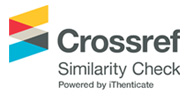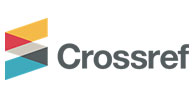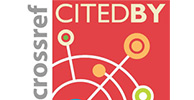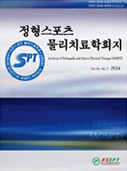Ⅰ. 서 론
뇌졸중(stroke)은 전 세계적으로 사망률 2위를 차지하 고 있으며, 뇌혈관의 출혈 및 경색으로 인해 심각한 신경 학적 장애가 발생하는 후천적 질환이다(Murphy & Werring, 2020;Donkor, 2018). 뇌졸중의 위험 요인은 고 혈압, 당뇨병, 심방 세동, 이상 지질 혈증, 편두통, 비만 및 흡연 등을 포함하고 있으며(Yoon & Bushnell, 2023), 대부분의 뇌졸중 환자는 근력 약화, 팔다리 마비, 감각 이 상 및 인지 장애로 인해 균형 및 보행능력에 장기적인 운 동 장애를 겪는다(Saleh et al., 2019;Balami et al., 2013). 특히 뇌졸중 환자는 관절 가동 범위 제한, 마비 및 협응 저하로 인해 보행 문제가 발생하며, 이로 인해 보폭 및 보행 속도가 감소하면서(Patel & Bhatt, 2014;Hillier & Lai, 2009), 비정상적인 보행 패턴이 나타난다(Chen & Patten, 2006). 또한 약 40%의 뇌졸중 환자는 인지 장애 가 동반된다(Baydan et al., 2019;Faria et al., 2016). 인 지 장애가 있는 환자는 사고력, 기억력, 집중력, 판단력, 언어력 및 학습 능력 등의 기능이 저하되어, 일상생활에 서의 감각 수용, 동작 수행 및 자기 조절 능력에 문제가 발생한다(Wang et al., 2015). 인지 장애는 환경을 인지하 는 정보 처리 능력을 저하시키고, 균형 및 보행 능력에도 영향을 미친다. 또한 낙상의 위험이 증가하면서 다양한 일상생활 활동에 어려움을 초래하게 된다(Baydan et al., 2019;Laver et al., 2017).
이러한 뇌졸중 환자의 복합적인 증상 개선을 위해 뇌 가소성 원리를 기반으로 한 인지-운동 이중과제 프로그램 에 대한 필요성이 제시되고 있다(Rodríguez et al., 2014). 이중과제는 명확한 목표를 가지고 두 가지 작업을 동시에 수행하는 것을 의미한다(McIsaac et al., 2015). 이중과제는 일상생활과 밀접한 관계가 있으며, 과제와 단계를 환자 상태에 따라 조절함으로써 운동 학습에 효율적이지만(Carr et al., 2010) 이중과제의 복잡한 동작은 흥미 및 동기부여에 부정적인 영향을 미칠 수 있다(Forkan et al., 2006). 따라서 환자 특성에 맞는 강도 조절과 시각적 이미지를 통해 흥미를 유발하고, 더 적극적으로 치료에 참여할 수 있는 게임을 이용한 가상현실 프로그램이 제시되고 있다(Clay et al., 2020;Micarelli et al., 2019). 가상현실은 PC 프로그램을 통해 실제 환경과 상황을 모방하여 다양한 신체 활동을 수행하는 것을 의미하며(Sherman & Craig, 2018), 가상현 실 프로그램은 환자에게 동기부여와 참여율을 높이고, 외부 자극을 제공하여 균형, 보행 및 인지 기능 향상에 효과적이다 (Lloréns et al., 2015;Corbetta et al., 2015).
선행 연구에 의하면, 뇌졸중 환자에게 스포츠 엑서 게 임 훈련을 통해 인지 기능, 보행 및 우울증 개선에 영향을 미치게 된다고 하였다(Lin et al., 2023). Gamito 등(2017) 은 뇌졸중 환자에게 엑서 게임을 적용하여 기억력과 주의 력에 긍정적인 효과가 있다고 하였으며, Tetik 등(2019)은 만성 뇌졸중 환자에게 인지 작업을 동반한 이중과제를 적 용하여 보행 시 이동성 및 균형 능력에 많은 영향을 미치 게 된다고 하였다. Pang 등(2018)은 만성 뇌졸중 환자에 게 전방 보행 중 언어적, 사고적 능력을 결합한 인지-운 동 이중과제 훈련을 적용하여 보행 및 인지 기능에 효과적 이라고 하였다.
이와 같이 고령화와 함께 뇌졸중 발병률이 증가함에 따 라 치료에 대한 관심이 대두되고 있으며, 의료 기술의 발 전으로 다양한 접근법이 제시되고 있다. 특히 인공지능 게임 프로그램 및 인지-운동 이중과제가 뇌졸중 환자 치 료의 효과적인 대안으로 제시되고 있다. 그러나 뇌졸중 환자를 대상으로 게임 프로그램과 이중과제에 대한 단일 연구는 많이 이루어졌으나 게임을 기반한 이중과제에 대 한 연구는 부족한 실정이다. 따라서 본 연구의 목적은 뇌 졸중 환자를 대상으로 게임 기반 이중과제 훈련이 보행 및 인지 기능에 미치는 효과를 검증하여 임상적 기초 자료 로 제공하는 데 있다.
Ⅱ. 연구 방법
1. 연구 대상자
본 연구는 M시에 위치한 요양병원에 입원 후 물리치료를 받고 있는 뇌졸중 환자 20명을 대상으로 실시하였다. 대상자 들의 선정 기준은 단층화 촬영(computed tomography, CT) 및 자기공명영상(magnetic resonance imaging, MRI)에 의해 뇌졸중 진단을 받고 1년 이상 3년 미만인 자, 편측 무시를 포함한 시각 및 청각 능력에 문제가 없는 자, 보행 도구를 이용하거나 독립적으로 10m 이상 보행이 가능한 자, 한국형 간이정신상태 검사(mini-mental state examination- Korean, MMSE-K) 점수 24점 이상으로 소통이 가능한 자로 하였으며, 뇌졸중 외 기타 신경학적 증상을 진단받은 자, 퇴행성 관절 질환 및 요통이 있는 자는 제외하였다. 본 연구는 뇌졸중 환자 20명을 표본 추출하여 게임 기반 이중과제 훈련 그룹 10명과 일반적인 물리치료 그룹 10명을 무작위로 나누어서 실시하였으며, 연구 대상자 수는 Swinnen 등(2021)의 연구를 참고하였다. 실험군(EG)은 게 임 기반 이중과제 훈련을 추가로 하루 30분 중재하였고, 대조군(control group, CG)은 일반적인 물리치료를 하루 30분씩 2회 중재하였다. 각 집단의 총 중재 시간은 하루 60분으로 동일하다. 본 연구는 2024년 4월부터 6월까지 진행하였으며, 모든 연구대상자는 선정 기준에 부합한 자를 대상으로 하였으며, 본 연구에 대한 적절한 설명 후 자발적으 로 참여에 동의하고 참여 동의서에 서명한 자로 하였다. 일반적인 특성은 다음과 같다(Table 1). 이 논문은 연구자의 학위논문을 기반으로 하여 연구가 진행되었습니다.
Table 1
General characteristics of study participants (N=20)
| EG (n=10) | CG (n=10) | t | p′ | |
|---|---|---|---|---|
|
|
||||
| Mean±SD | ||||
|
|
||||
| Age (years) | 74.09±2.81 | 73.27±3.52 | .181 | .858 |
| Hight (㎝) | 159.45±2.59 | 162.54±4.01 | .647 | .525 |
| Weight (㎏) | 60.68±3.37 | 55.54±4.51 | .912 | .373 |
| Gender (M/F) | 6/4 | 7/3 | .302 | .769 |
Mean±SD : mean±standard deviation
independent t-test
shapiro–wilk test
EG : experimental group
CG : control group
M/F : male/female
2. 측정도구 및 실험도구
1) G-Walk
분속수(cadence), 보행 속도(velocity), 한 발짝 거리 (stride length)에 대한 보행 측정을 위해 G-Walk(G-Walk, BTS bioengineering, 이탈리아)를 사용하였다(Figure 1). 착용 방법은 L5 척추뼈 부위에 G-Walk를 배치하고, 신축성 이 있는 벨트로 허리에 고정시켰다(Boudarham et al., 2013). 보행 측정은 연구대상자가 선택한 신발을 신고 10 m 트랙을 ‘준비-출발’이라는 구령에 맞춰 보행로를 걷기 시작하였으며, 정확한 측정을 위해 10 m 지점에서 2 m 떨어진 곳에 결승선을 두고 끝까지 걷도록 하였다. 측정 데이터는 100Hz 주파수로 샘플링 되어 Bluetooth를 통해 노트북으로 전송되고, 특수 소프트웨어인 BTS G-Studio (BTS bioengineering SpA, 이탈리아)를 사용하여 데이터를 처리하였다(Wright et al., 2022;Vítečková et al., 2020). G-Walk는 우수한 신뢰성(0.85–0.99) 및 타당성(0.88– 0.97)을 보인다(De Ridder et al., 2019;Pau et al., 2014). 측정은 총 3회 실시하여 평균값을 적용하였다.
2) 한국형 몬트리올 인지평가(K-MoCA, korean version of montreal cognitive assessment)
인지 기능 평가를 위해 한국형 몬트리올 인지평가 (K-MoCA)를 실시하였다(Figure 2). K-MoCA는 Nasreddine 등(2005)이 경도 인지 장애를 빠르게 선별하기 위해 개발한 평가도구를 Lee 등(2008)이 한국의 언어적, 문화적 특성에 맞춰 수정, 보완하였다. 평가도구는 다음과 같이 구성된다. 시공간 실행력 5점, 어휘력 3점, 주의력 6점, 문장력 3점, 추상력 2점, 지남력 6점, 회상력 5점을 평가한다. 총 30점 만점 중 23점 이상 시 정상으로 구분하며, 도구의 컷오프 값은 22/23점으로, 특이도 70%, 민감도 82%, 신뢰도는 0.75 이다(Salvadori et al., 2022;Potocnik et al., 2020).
3. 실험절차
1) 게임 기반 이중과제 훈련
본 연구에서 게임 기반 이중과제 훈련은 균형 및 인지 훈련 시스템(Dividat senso, dividat AG, 스위스)을 이용 하였다(Figure 3). 본 시스템은 체중 이동, 걸음 및 신체 움직임에 의해 발생하는 힘을 동작으로 기록한다. 대상자 는 기기에 연결된 화면을 통해 청각적, 시각적 피드백을 제공받고 있으며, 플레이트 진동으로 촉각적 피드백도 제 공한다. 또한 Dividat senso는 일상생활 활동에 중요한 인 지 기능(주의력, 실행 기능)과 균형 및 자세 조절과 같은 신체적 기능의 향상에 목적을 두고 있다(Büttiker et al., 2024). 훈련은 5개의 압력 감지 플레이트 위에서 네 개의 방향(앞, 뒤, 좌, 우)으로 체중 이동 및 발걸음의 움직임을 통해 화면에 나오는 다양한 게임을 진행한다. 대상자는 균형을 유지하여 목표 지점에 도달하기, 시각적 반응을 통한 발 이동시키기와 같은 과제들로 이루어져 있다 (Jäggi et al., 2023;Altorfer et al., 2021). 훈련 중 대상 자는 화면에 나오는 장애물을 피하기 위해 체중과 발걸음 옮기기와 신체 균형을 유지하고, 빠르게 반응하여 목표 지점에 도달하는 과제를 진행하며, 게임 수행을 통해 반 응 시간, 균형 능력, 신체의 민첩성을 훈련한다(Büttiker et al., 2024;Swinnen et al., 2021). 훈련은 하루 30분, 주 5일 6주간 제공되었으며, 모든 대상자는 5개의 서로 다른 게임을 각각 5분씩 플레이하였다. 연구 대상자는 1주 동안 훈련 후, 더 어렵고 새로운 게임이 도입되었으며, 적 절한 훈련을 보장하기 위해 Dividat Senso 소프트웨어에 각 대상자들의 훈련 계획이 저장되고, 각 대상자의 수준 에 맞춰 훈련의 난이도를 실시간으로 자동 조절할 수 있다 (Altorfer et al., 2021). 반면 치료사는 게임 성과가 너무 낮거나, 게임이 너무 쉽거나 어렵다는 환자의 주관적인 보고에 따라 훈련 계획을 조정하도록 하였다(Park, 2012;Seidler et al., 2010).
2) 일반적인 물리치료
모든 대상자는 전문적인 교육과정을 이수한 임상 물리 치료사가 신경발달치료(neurodevelopmental treatment; NDT)의 운동 학습과 운동 조절 이론에 기초한 일반적인 물리치료를 중재하였다.
일반적인 물리치료 절차는 네 가지로 구성하였다. 첫 번째는 수동 및 능동 관절 가동 범위 운동 및 스트레칭으 로 이루어졌으며, 두 번째는 근력 강화 운동(muscle strengthening exercise)으로, 엉덩 관절과 무릎 관절의 굽힘, 폄, 교각 운동, 누운 자세에서 번갈아가며 다리 들 기, 앉아서 일어나기와 일어선 자세에서 앉은 자세 등을 실시하였다. 세 번째는 균형 훈련(balance training)으로, 마비 측 하지에 무게 중심을 이동시켜 선 자세를 유지하도 록 훈련하고, 치료사의 도움 하에 선 자세에서 한 발 서기 연습을 실시하였다. 네 번째는 보행 훈련(gait training) 은, 치료사의 감독 하에 독립적으로 평지 보행을 실시하 며, 도움이 필요한 경우 보조 도구를 사용하였다(Taylor- Schroeder et al., 2011). 일반적인 물리치료는 주 5일 6주 간 제공되었으며, 실험군은 1일 1회 30분, 대조군은 1일 2회 30분씩 중재하였다.
4. 자료분석
본 연구에서 수집된 자료는 SPSS version 29.0 for Windows 통계 프로그램을 이용하여 분석하였다. 연구대 상자의 일반적인 특성에 대한 동질성을 확인하기 위해 Levene의 등분산 검정(Levene’s test)을 우선 실시하였으 며, 검사결과 등분산이 성립된 변수는 추가로 독립표본 t-검정(independent t-test)을 통해 두 집단 간의 동질성 을 확인하였다. 각 집단의 정규성 검정은 Shapiro-Wilk 검정을 시행하였으며, 집단 내 보행 및 인지 기능을 비교 분석하기 위해 대응표본 t-검정(paired t-test)을 시행하 였다.두 집단 간의 보행 및 인지 기능을 비교 분석하기 위해 공분산 분석(ANCOVA)을 실시하였으며, ANCOVA 분석 시 각 변수의 Pre값(사전 측정값)을 공변량으로 설정 하여 실험군과 대조군 간 차이를 분석하였다. 통계학적 유의 수준은 α= .05로 하였다(Table 1).
Ⅲ. 연구 결과
1. 실험군 중재에 따른 비교
게임 기반 이중과제 훈련을 받은 실험군의 중재 전⋅후 변수 변화는 다음과 같다. 분속수 변화는 중재 전 96.69± 3.97 steps/min에서 중재 후 99.45±3.49 steps/min로 통 계학적으로 유의한 차이를 보였다(p<.05). 보행 속도 변화 는 중재 전 0.72±0.14 m/s에서 0.88±0.17 m/s로 통계학 적으로 유의한 차이를 보였다(p<.01). 한 발짝 길이 변화 는 중재 전 1.77±0.19 cm에서 1.99±0.24 cm로 통계학적 으로 유의한 차이를 보였다(p<.05). 인지 기능 총점의 변 화는 중재 전 17.10±2.99점에서 중재 후 19.50±2.59점으 로 통계학적으로 유의한 차이를 보였다(p<.05)(Table 2).
Table 2
Comparison of variances within experimental group (unit : steps/min, m/s, cm, point)
| Pre | Post | t | p′ | |
|---|---|---|---|---|
|
|
||||
| Mean±SD | ||||
|
|
||||
| cadence | 96.69±3.97 | 99.45±3.49 | -3.113 | .012* |
| velocity | 0.72±0.14 | 0.88±0.17 | -3.989 | .003** |
| stride length | 1.77±0.19 | 1.99±0.24 | -3.111 | .012* |
| K-MoCA | 17.10±2.99 | 19.50±2.59 | -2.676 | .025* |
′ : paired t-test
Mean±SD : mean±standard deviation
*p<.05, **p<.01
K-MoCA : korean version of montreal cognitive assessment
2. 대조군 중재에 따른 비교
일반적인 물리치료를 받은 대조군의 중재 전⋅후 변수 변화는 다음과 같다. 분속수 변화는 중재 전 97.79±3.20 steps/min에서 중재 후 99.97±3.64 steps/min로 통계학 적으로 유의한 차이를 보였으며(p<.01), 보행 속도 변화는 중재 전 0.78±0.11 m/s에서 0.85±0.11 m/s로 통계학적 으로 유의한 차이를 보였으며(p<.05), 한 발짝 길이 변화 는 중재 전 1.79±0.13 cm에서 1.92±0.13 cm로 통계학적 으로 유의한 차이를 보였다(p<.001). 인지 기능 총점의 변 화는 중재 전 18.60±3.09점에서 중재 후 20.00±2.94점 으로 통계학적으로 유의한 차이를 보였다(p<.05)(Table 3).
Table 3
Comparison of variances within control group (unit : steps/min, m/s, cm, point)
| Pre | Post | t | p′ | |
|---|---|---|---|---|
|
|
||||
| Mean±SD | ||||
|
|
||||
| cadence | 97.79±3.20 | 99.97±3.64 | -4.032 | .003** |
| velocity | 0.78±0.11 | 0.85±0.11 | -2.364 | .042* |
| stride length | 1.79±0.13 | 1.92±0.13 | -4.904 | .000*** |
| K-MoCA | 18.60±3.09 | 20.00±2.94 | -2.492 | .034* |
′ : paired t-test
Mean±SD : mean±standard deviation
*p<.05, **p<.01, ***p<.001
K-MoCA : korean version of montreal cognitive assessment
3. 집단 간 중재에 따른 비교
게임 기반 이중과제 훈련을 받은 실험군과 일반적인 물 리치료를 받은 대조군의 집단 간 중재 전⋅후 변수 변화 는 다음과 같다. 분속수 변화는 실험군(EG) 96.69±3.97 steps/min에서 99.45±3.49 steps/min로 대조군(CG) 97.79±3.20 steps/min에서 99.97±3.64 steps/min로 통 계학적으로 유의한 차이를 보였고(p<.001), 보행 속도 변 화는 중재 후 실험군(EG) 0.72±0.14 m/s에서 0.88±0.17 m/s로 대조군(CG) 0.78±0.11 m/s에서 0.85±0.11 m/s로 통계학적으로 유의한 차이를 보였으며(p<.001), 한 발짝 길이 변화는 실험군(EG) 1.77±0.19 cm에서 1.99±0.24 cm로 대조군(CG) 1.79±0.13 cm에서 1.92±0.13 cm로 통 계학적으로 유의한 차이를 보였다(p<.01). 인지 기능 총점 의 변화는 실험군(EG) 17.10±2.99점에서 19.50±2.59점 으로, 대조군(CG) 18.60±3.09점에서 20.00±2.94점으로 통계학적으로 유의한 차이를 보였다(p<.01)(Table 4).
Table 4
Comparison of variances between groups (unit : steps/min, m/s, cm, point)
| EG (n=10) | CG (n=10) | t | p′ | ||
|---|---|---|---|---|---|
|
|
|||||
| Mean±SD | |||||
|
|
|||||
| cadence | Pre | 96.69±3.97 | 97.79±3.20 | 28.382 | .000** |
| Post | 99.45±3.49 | 99.97±3.64 | |||
| velocity | Pre | 0.72±0.14 | 0.78±0.11 | 14.566 | .001** |
| Post | 0.88±0.17 | 0.85±0.11 | |||
| stride length | Pre | 1.77±0.19 | 1.79±0.13 | 9.611 | .007* |
| Post | 1.99±0.24 | 1.92±0.13 | |||
| K-MoCA | Pre | 17.10±2.99 | 18.60±3.09 | 14.103 | .002* |
| Post | 19.50±2.59 | 20.00±2.94 | |||
′ : ANCOVA
Mean±SD : mean±standard deviation
*p<.01, **p<.001
EG : experimental group
CG : control group
K-MoCA : korean version of montreal cognitive assessment
Ⅳ. 고 찰
본 연구는 뇌졸중 환자에게 게임 기반 이중과제 훈련을 적용하여 보행 능력과 인지 기능의 변화를 알아보고자 하 였다. 뇌졸중은 뇌혈관 손상으로 인해 신경학적 장애가 발생하는 질환으로, 환자는 신체 기능의 제한으로 인하여 일시적 또는 영구적인 인지 및 신체적 장애를 경험하게 된다(Kleindorfer et al., 2021;Alawieh et al., 2018;O'Sullivan et al., 2014). 특히, 근력 약화, 균형 능력 저 하, 비대칭적인 자세는(Kazi et al., 2022), 환자의 보행 능력 및 이동성에 직접적인 영향을 미친다(Bang & Cho, 2016). 이러한 문제점을 해결하기 위한 다양한 치료 방법 중 이중과제 훈련은 뇌졸중 환자의 보행 및 인지 기능을 동시에 향상시키기 위한 효과적인 방법이다. 이중과제는 두 가지 과제를 동시에 실시하는 것을 의미하며, 신체 활 동과 인지 과제를 결합한 것이다(McIsaac et al., 2015). 이중과제 훈련은 복잡한 환경에서 신체적 과제와 인지적 과제를 수행함으로써 뇌졸중 환자의 보행 능력, 낙상 감 소 및 인지 기능에 긍정적인 영향을 준다(Chiaramonte et al., 2022). 본 연구에서 게임 기반 이중과제 훈련은 신체 적, 인지적 과제를 결합한 균형 및 인지 훈련 시스템을 사용하여 뇌졸중 환자의 보행, 및 인지 기능 훈련을 실시 하였다(Huber et al., 2021). 본 연구에서는 보행 능력 분 석을 위해 G-Walk 관성 센서를 사용하였다. 본 연구결과 중재 후 실험군, 대조군의 분속수, 보행속도, 한 발짝 길 이에 통계학적으로 유의한 차이가 있었다. Jaggi 등 (2023)은 파킨슨 환자 40명을 대상으로 엑서게임 인지- 운동 이중과제를 4주간 적용 후 보행 능력을 비교한 결과 실험군의 보행 능력이 향상되었으며, 특히 보행 속도에서 큰 변화를 보여 통계학적으로 유의한 차이를 보였다고 보 고하였다. Huber 등(2021)은 만성 뇌졸중 환자를 대상으 로 주당 2회, 8주간 게임 기반 인지-운동을 적용 후 보행 능력을 비교한 결과 대부분의 보행 능력이 증가하였으며, 통계학적으로 유의한 차이가 있다고 보고하였다. 이러한 결과는 본 연구의 결과와 유사한 결과이다. 본 연구에서 실험군의 보행 능력이 개선된 이유는 구체적으로 구성된 과제를 제시하고, 직접 동작을 계획하며, 움직임을 연속 적으로 실행시켜 근 골격계의 운동기능과 협응, 고유 감 각 등 중추신경계의 적절한 전기적 신호를 신경망을 통해 전달되어 신체의 생체역학적 요구가 만족 되었기 때문에 보행 능력에 유의한 차이가 나타난 것으로 생각된다. 본 연구에서는 인지 기능 분석을 위해 한국형 몬트리올 인지 평가(K-MoCA)를 사용하였다. 본 연구결과 실험군, 대조 군의 인지 기능 점수가 통계학적으로 유의한 차이가 있었 다. Altorfer 등(2021)은 39명의 노인 입원 환자들을 대상 으로 엑서 게임 이중과제 그룹과 일반 재활 그룹의 보행 인지 능력을 비교 분석한 결과 두 그룹 모두 인지 능력이 향상되었으며, 특히 이중과제 훈련 그룹에서 인지 능력이 대조군에 비해 큰 변화를 보여 통계학적으로 유의한 차이 를 보였다. Huber 등(2024)은 만성 뇌졸중 환자를 대상으 로 일반적인 물리치료에 추가로 게임 기반 이중과제 훈련 을 실시한 결과, 주의력, 실행 기능, 학습 및 기억 등을 포함한 대부분의 인지 기능에 효과가 있다고 보고하였다. 이러한 결과는 본 연구의 결과와 유사한 결과이다. 본 연 구에서 실험군의 인지 능력이 개선된 이유는 게임 기반 이중과제의 영향이 미친 것으로 보이며, 게임 기반 이중 과제를 중재하는 동안 기억력, 집중력, 시각적 공간력, 반 응력, 수학적 산술 능력, 균형 능력 등의 과제를 포함한 시각적인 훈련이 자발적인 움직임을 만들고 복합적인 인 지 기능을 사용하게 함으로써 본 연구의 인지 기능 결과에 긍정적 영향을 미쳤다고 생각한다. 본 연구결과 게임 기 반 이중과제 훈련은 뇌졸중 환자의 보행 능력 및 인지 기 능에 긍정적인 영향을 미치는 것을 확인하였다.
본 연구의 제한점은 다음과 같다. 첫째, 연구 대상자 수가 적다. 둘째, 다른 환자에게 일반화하기 어렵다. 셋 째, 동일한 훈련 제공이 어렵다. 따라서 향후 연구에서는 동일한 조건을 제공하여 뇌졸중 환자의 보행 및 인지 기능 에 미치는 효과에 대한 다양한 연구가 필요할 것으로 생각 된다.
Ⅴ. 결 론
본 연구는 게임 기반 이중과제 훈련이 뇌졸중 환자의 보행 및 인지 기능에 대한 변화를 비교해 보고자 실시하였 다. 연구결과 게임 기반 이중과제 훈련은 일반적인 물리 치료만 제공했을 때 보다 뇌졸중 환자의 보행 및 인지 기 능 향상에 효과적임을 확인하였다. 본 연구에서 게임 기 반 이중과제 훈련은 보행 및 체중의 이동을 통한 신체적 과제와 숫자 세기 및 시각적 반응을 요구하는 인지적 과제 를 통하여, 뇌의 신경가소성을 촉진시켜 보행 능력과 인 지 기능을 동시에 개선하는데 효과적임을 보였다. 이러한 결과를 바탕으로 게임 기반 이중과제 훈련은 뇌졸중 환자 의 보행 및 인지 기능에 있어 임상적 가치가 크다고 사료 된다.

















